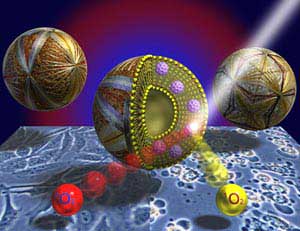| Posted: April 10, 2007 |
Hollow success - buckyballs for cancer treatment |
|
(Nanowerk News) Trapping C60 Buckyballs in lipid globes could deliver improved cancer treatments, say Japanese researchers.
|
|
Atsushi Ikeda and colleagues from the Nara Institute of Science and Technology in Ikoma showed that the carbon isotope C60 could be delivered into human cancer cells by hollow lipid spheres and used to induce cell death under visible light irradiation. Combining a light source with a light-sensitive drug - a photosensitiser - to destroy cancer cells in this way is the principle behind photodynamic therapy (PDT).
|
 |
| C60 trapped in a lipid membrane releases toxic singlet oxygen to kill cancer
|
|
C60 yields singlet oxygen under irradiation and it is this that induces cell death. The problem facing Ikeda was how to dissolve the insoluble C60 in water and so open the possibility of transporting the compound into the cancer cells. Whilst some C60 derivatives are soluble in water, unmodified C60 yields singlet oxygen more efficiently. So, Ikeda's solution was to use a charged lipid membrane to deliver the C60 rather than to modify it directly.
|
|
The group used various lipids, including phospholipids and aminolipids, to make the lipid membrane-C60 structures, called LMI[60]fullerenes. The LMI[60]fullerene with a cationic surface was found to have a considerably higher PDT activity than the structures with anionic and neutral surfaces, said Ikeda.
|
|
Due to their large size, LMI[60]fullerenes could lead to enhanced permeability and retention effects, said Ikeda. This would mean that they would enter and accumulate in tumour tissue much more than in normal tissue.
|
|
Ikeda said that a future challenge will be to develop PDT photosensitisers with specific tissue distribution properties. His plan is to study the enhanced permeability and retention effects of LMI[60]fullerenes and also to tune the lipid membrane surface using various lipids with functional groups. He hopes that the structures will one day find wide use in medicine. 'LMI[60]fullerenes will be used not only as a new cancer therapy, but also as antibacterial or antifungal agents,' said Ikeda.
|

